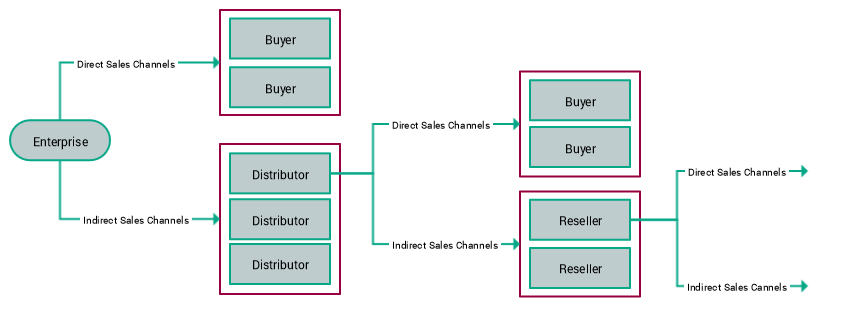Basic Concepts
This section introduces basic concepts as well as main application components of Intershop Commerce Management. The information is designed to provide a rough overview of Intershop Commerce Management, with each topic addressed in more detail in subsequent sections.
Main Goals
Intershop Commerce Management is designed to:
-
Allow organizations to sell goods and services via the Internet to their direct customers with personalized storefronts and customer-specific catalogs
-
Provide commercial services to distributors or agents which do not have e-commerce capability of their own initiative
-
Easily integrate with the sell-side and/or ERP systems of customers and partners
Actors
- Sales Organization
The sales organization represents the owner or root organization of a system that implements a multi-channel sales business model. Typically, the sales organization represents an organization which manages its demand chain, publishes content and manages orders.
Sales Organizations use Intershop Commerce Management to:
-
Manage the internal structure of the sales organization, such as departments, users, and roles.
-
Create and manage channels for partners and customers.
-
Manage catalogs and publish them through sales channels.
-
Sell goods and services to customers.
-
Receive orders that can be fulfilled directly or exported to external systems.
-
- Partners
Partners represent selling organizations working within a partner channel. Hence, partners always have a superordinate or parent organization. The parent organization can be the sales organization, or another partner higher up in the demand chain.
Partners use Intershop Commerce Management to:
-
Manage the internal structure of the sales organization, such as departments, users, and roles.
-
Syndicate products from the parent organization.
-
Create and manage channels for partners and customers.
-
Manage catalogs and publish them through sales channels.
-
Sell goods and services to customers.
-
Receive orders that can be fulfilled directly or exported to external systems.
-
- Customers
Customers represent the individual or corporate buyers of a sales or partner organization. Customers use the sales channel of Intershop Commerce Management to:
-
Browse catalogs made available to them.
-
Create and manage baskets/requisitions.
-
Create orders.
-
Participate in online marketing campaigns.
-
- Central Administrators
Intershop Commerce Management includes a business application to perform central administration tasks, such as creating sales organizations, managing security settings, and initiating data replication processes.
Note:Central administrators are also responsible for managing central system resources, such as pipelines and templates, locales, system-wide settings for payment, tax and shipping methods. Many of these tasks are performed outside the business applications and require access to properties files and other system resources.
Channels
Sales and partner organizations set up channels to syndicate products to partners, to sell to customers, and to receive orders.
Intershop Commerce Management predefines certain channel types. The predefined channel types include:
-
Partner channel
-
Sales channel
The channel type defines:
-
The business processes (including the front end applications) a partner or customer can use
-
The administrative tools available to manage the sales channel
For example, the sales channel provides the storefront (the front end application) that customers use to browse catalogs and create orders. In addition, the channel provides administrative tools to manage the sales channel and the corresponding data, such as catalogs designed for customers or orders generated by customers.


Applications
Intershop Commerce Management can run multiple applications in the context of a channel or site. An application is a self-contained functional unit, based on an application type. Typically, each application type defines an individual set of functionality in order to support dedicated business processes (like for B2C or B2B) or serve dedicated front ends (for example, mobile devices).
The applications of one channel may share the channel data repositories or may use their own, application-specific data repositories. That is, an application can share, for example, the product data, user data and order data with the channel, but use its own content assets. The effective repository relations depend on the underlying application implementation.
One application must be set as default, which means that it will be launched as the site's standard application if the URL does not include another application's URL identifier.
Applications provide a "preview" mode. As part of the content management (see Storefront Design View (Responsive Starter Store)), the application preview constitutes a powerful means to immediately preview the effect of certain actions triggered in Intershop Commerce Management directly on the website, including promotion settings, price changes, etc.
For details about applications, see Application Management: Concepts.
Demand Chains
Based on the channel concept, Intershop Commerce Management enables sales and partner organizations to create demand chains which are tailored precisely to their business needs.

Besides channels, demand chains are based on two essential features: product syndication and sharing as well as order processing.
Product Syndication and Product Sharing
Intershop Commerce Management provides two mechanisms for distributing products across channels: product sharing and product syndication.
-
Product Sharing
With product sharing, sales or partner organizations can distribute large numbers of master products to sales channels. The products are not copied to the target channels but remain in the parent organization's master repository.
-
Product Syndication
With product syndication, sales channels can derive master products from parent sales or partner organizations. The master products are actually copied to the channel repositories.
Each organization can set up a master repository for products. Via product sharing or syndication processes, products can flow down the demand chain: from the master repositories to the channel repositories, then to the master and channel repositories of partner organizations, from there to the repositories of an indirect reseller, and so on.
For more details about the two product distribution mechanisms, see Product Sharing vs. Product Syndication.
Order Processing
Complementary to the product distribution processes, which distribute products down the demand chain, orders generated inside channels are forwarded (one level) up the demand chain. That is,
-
Orders can be fulfilled directly in the channel, or
-
Orders (or individual order line items) can be processed by the sales organization that operates the channel.
Via the order export functionality, orders can be prepared for being processed by other organizations or external systems.
